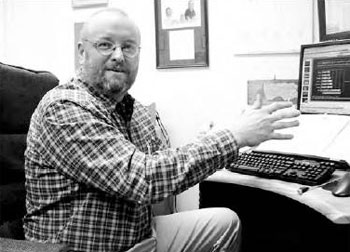Local doctor not alone in favoring national health insurance
By JOHN BULGER
Idaho Statesman
Apr 4, 2008
jbulger@journalnet.com
Pocatello physician Bill Woodhouse delivers a grim prognosis on the state of health care in America.
“We’re dealing with a catastrophe of the first order,” Woodhouse said.
Woodhouse is not alone in his opinion. A recent study in Annals of Internal Medicine reported that a solid majority — 59 percent — of U.S. physicians support national health insurance.

Local physician Dr. Bill Woodhouse advocates the adoption of
a national health care plan.
JOURNAL PHOTO BY JOHN BULGER
An estimated 47 million Americans currently lack health insurance coverage, and 50 million more are believed to be underinsured. Health care costs are rising approximately 7 percent per year, twice that of inflation.
“It’s the greatest moral failing of our times,” Woodhouse said.
Woodhouse is a family physician, a past president of the Idaho Academy of Family Physicians, and a former opponent of a single-payer health care system that many industrialized nations employ. But Woodhouse experienced a change of heart a few years ago.
“I got tired of going to bed thinking I was part of something corrupt,” he said.
Woodhouse is now active in state and national groups advocating for health care reform. He speaks on the topic frequently, armed with statistics which are troubling.
- The U.S. spent $2 trillion on health care in 2007. And $1 trillion of that amount went to administrative costs.
- We pay nearly twice as much per person for health care than Switzerland, the second-most expensive nation.
- More than 50 percent of U.S. bankruptcies are now medically related.
Woodhouse points to a 2000 study in Seattle which encompassed 2,777 patients. The patient pool had 755 individual insurance plans, with differing benefits, co-payments, deductibles and coverage rules.
The upshot of such a fragmented pay system?
“It costs three times more to administer a practice here than in Canada,” Woodhouse said.
Canadian health care providers never need question where to bill insurance. It goes to the province’s health care provider. Every Canadian citizen is insured under the Canada Health Act’s tax-supported system.
Canada’s tax spending was $880 per person in 2002. The U.S. spent $2,130 per person.
A poll by the World Health Organization found 54 percent of Canadians were satisfied, while only 49 percent of Americans were pleased with their overall care.
Woodhouse notes the vicious cycle of cost shifting that occurs in our system. Fixed costs rise, which result in higher premiums. Higher premiums result in more people being uninsured or underinsured, many of whom delay seeking treatment until forced to visit a doctor. The illnesses are then more acute, resulting in higher costs. Unable to pay for the services out of pocket, the health care system absorbs the charge and fixed costs increase. And upward it spirals.
“We put people in the hospital every week who wouldn’t be there if they had primary care,” Woodhouse said.
And the results are sobering. More than 18,000 deaths are attributed annually to lack of insurance.
“That’s six 9/11s every year,” he said.
A visit to the Pocatello Free Clinic illustrates the problems with the system. Go there any day, he said, and the clinic is crowded with women between 50 and 65 years of age.
“Their chronic medical conditions are patched together until they can qualify for Medicare (at age 65),” Woodhouse said. “And most people down there? They’re working one or two jobs.”
Personal finances shouldn’t be part of the thought process when seeking medical care, Woodhouse said. He argues we need to start treating health care as a common good, similar to education, fire prevention and road maintenance.
“Two o’clock in the morning, your chest starts hurting. What happens next is not a business transaction,” he said.
Despite the daunting challenge of reform, Woodhouse remains optimistic, although he does not see a banner carrier for a single-payer system among current policy makers. But he believes change is inevitable in a broken system.
“What’s the tipping point?” he muses. “We’re getting there.”



